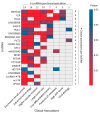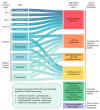The Landscape of lncRNAs in Hepatocellular Carcinoma: A Translational Perspective
- PMID: 34071216
- PMCID: PMC8197910
- DOI: 10.3390/cancers13112651
The Landscape of lncRNAs in Hepatocellular Carcinoma: A Translational Perspective
Abstract
LncRNAs are emerging as relevant regulators of multiple cellular processes involved in cell physiology as well as in the development and progression of human diseases, most notably, cancer. Hepatocellular carcinoma (HCC) is a prominent cause of cancer-related death worldwide due to the high prevalence of causative factors, usual cirrhotic status of the tumor-harboring livers and the suboptimal benefit of locoregional and systemic therapies. Despite huge progress in the molecular characterization of HCC, no oncogenic loop addiction has been identified and most genetic alterations remain non-druggable, underscoring the importance of advancing research in novel approaches for HCC treatment. In this context, long non-coding RNAs (lncRNAs) appear as potentially useful targets as they often exhibit high tumor- and tissue-specific expression and many studies have reported an outstanding dysregulation of lncRNAs in HCC. However, there is a limited perspective of the potential role that deregulated lncRNAs may play in HCC progression and aggressiveness or the mechanisms and therapeutic implications behind such effects. In this review, we offer a clarifying landscape of current efforts to evaluate lncRNA potential as therapeutic targets in HCC using evidence from preclinical models as well as from recent studies on novel oncogenic pathways that show lncRNA-dependency.
Keywords: biomarkers; hallmarks of cancer; hepatocellular carcinoma; long non-coding RNAs; translational research.
Conflict of interest statement
The authors declare no conflict of interest.
Figures





Similar articles
-
Roles and Regulation of Long Noncoding RNAs in Hepatocellular Carcinoma.Cancer Res. 2019 Oct 15;79(20):5131-5139. doi: 10.1158/0008-5472.CAN-19-0255. Epub 2019 Jul 23. Cancer Res. 2019. PMID: 31337653 Review.
-
The paradoxical functions of long noncoding RNAs in hepatocellular carcinoma: Implications in therapeutic opportunities and precision medicine.Genes Dis. 2020 Dec 1;9(2):358-369. doi: 10.1016/j.gendis.2020.11.014. eCollection 2022 Mar. Genes Dis. 2020. PMID: 35224152 Free PMC article. Review.
-
Functional long non-coding RNAs in hepatocellular carcinoma.Cancer Lett. 2021 Mar 1;500:281-291. doi: 10.1016/j.canlet.2020.10.042. Epub 2020 Oct 29. Cancer Lett. 2021. PMID: 33129957 Review.
-
New LncRNAs in Chronic Hepatitis C progression: from fibrosis to hepatocellular carcinoma.Sci Rep. 2020 Jun 18;10(1):9886. doi: 10.1038/s41598-020-66881-2. Sci Rep. 2020. PMID: 32555359 Free PMC article.
-
Function of the Long Noncoding RNAs in Hepatocellular Carcinoma: Classification, Molecular Mechanisms, and Significant Therapeutic Potentials.Bioengineering (Basel). 2022 Aug 21;9(8):406. doi: 10.3390/bioengineering9080406. Bioengineering (Basel). 2022. PMID: 36004931 Free PMC article. Review.
Cited by
-
ETS Proto-Oncogene 1-activated muskelin 1 antisense RNA drives the malignant progression of hepatocellular carcinoma by targeting miR-22-3p to upregulate ETS Proto-Oncogene 1.Bioengineered. 2022 Jan;13(1):1346-1358. doi: 10.1080/21655979.2021.2017565. Bioengineered. 2022. PMID: 34983308 Free PMC article.
-
Current updates on the molecular and genetic signals as diagnostic and therapeutic targets for hepatitis B virus-associated hepatic malignancy.Heliyon. 2024 Jul 8;10(14):e34288. doi: 10.1016/j.heliyon.2024.e34288. eCollection 2024 Jul 30. Heliyon. 2024. PMID: 39100497 Free PMC article. Review.
-
Comprehensive analysis of N6 -methyladenosine-related long non-coding RNAs for prognosis prediction in liver hepatocellular carcinoma.J Clin Lab Anal. 2021 Dec;35(12):e24071. doi: 10.1002/jcla.24071. Epub 2021 Nov 5. J Clin Lab Anal. 2021. PMID: 34741346 Free PMC article.
-
Macrophage polarization in hepatocellular carcinoma: a lncRNA-centric perspective on tumor progression and metastasis.Clin Exp Med. 2025 May 25;25(1):173. doi: 10.1007/s10238-025-01711-1. Clin Exp Med. 2025. PMID: 40413657 Free PMC article. Review.
-
Relevance of mutation-derived neoantigens and non-classical antigens for anticancer therapies.Hum Vaccin Immunother. 2024 Dec 31;20(1):2303799. doi: 10.1080/21645515.2024.2303799. Epub 2024 Feb 12. Hum Vaccin Immunother. 2024. PMID: 38346926 Free PMC article. Review.
References
Publication types
Grants and funding
LinkOut - more resources
Full Text Sources
Medical

